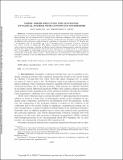Model Order Reduction for Stochastic Dynamical Systems with Continuous Symmetries
Author(s)
Mowlavi, Saviz; Sapsis, Themistoklis P.
Download17m1126576.pdf (4.904Mb)
PUBLISHER_POLICY
Publisher Policy
Article is made available in accordance with the publisher's policy and may be subject to US copyright law. Please refer to the publisher's site for terms of use.
Terms of use
Metadata
Show full item recordAbstract
Stochastic dynamical systems with continuous symmetries arise commonly in nature and often give rise to coherent spatio-temporal patterns. However, because of their random locations, these patterns are not captured well by current order reduction techniques, and a large number of modes is typically necessary for an accurate solution. In this work, we introduce a new methodology for efficient order reduction of such systems by combining (i) the method of slices [C. W. Rowley and J. E. Marsden, Phys. D, 142 (2000), pp. 1-19; S. Froehlich and P. Cvitanovi\'c, Commun. Nonlinear Sci. Numer. Simul., 17 (2012), pp. 2074-2084], a symmetry reduction tool, and (ii) any standard order reduction technique, resulting in efficient mixed symmetry-dimensionality reduction schemes. In particular, using the dynamically orthogonal (DO) equations [T. P. Sapsis and P. F. J. Lermusiaux, Phys. D, 238 (2009), pp. 2347-2360] in the second step, we obtain a novel nonlinear symmetry-reduced dynamically orthogonal (SDO) scheme. We demonstrate the performance of the SDO scheme on stochastic solutions of the one-dimensional Korteweg-de Vries and two-dimensional Navier-Stokes equations. Keywords: model order reduction, stochastic dynamical systems, symmetry reduction
Date issued
2018-01Department
Massachusetts Institute of Technology. Department of Mechanical EngineeringJournal
SIAM Journal on Scientific Computing
Publisher
Society for Industrial & Applied Mathematics (SIAM)
Citation
Mowlavi, Saviz, and Themistoklis P. Sapsis. “Model Order Reduction for Stochastic Dynamical Systems with Continuous Symmetries.” SIAM Journal on Scientific Computing 40, no. 3 (January 2018): A1669–A1695. © 2018 Society for Industrial and Applied Mathematics
Version: Final published version
ISSN
1064-8275
1095-7197